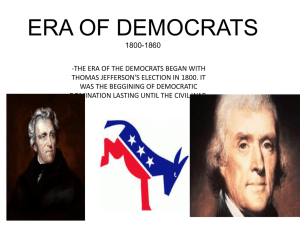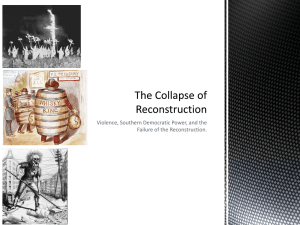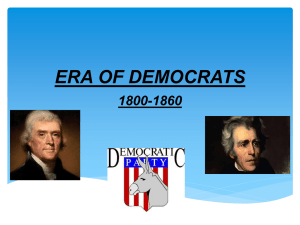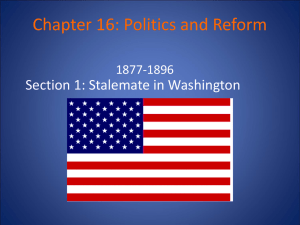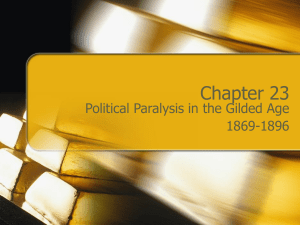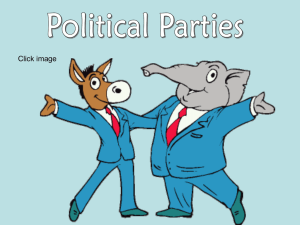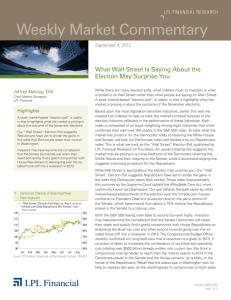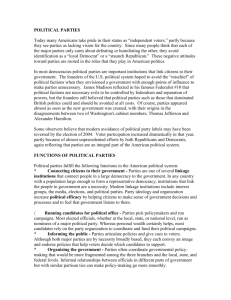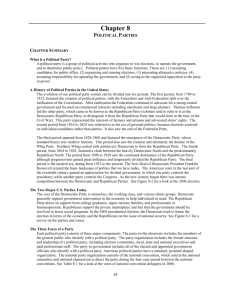Chapter 5: Political Parties Section 3: The Two Party System in
advertisement
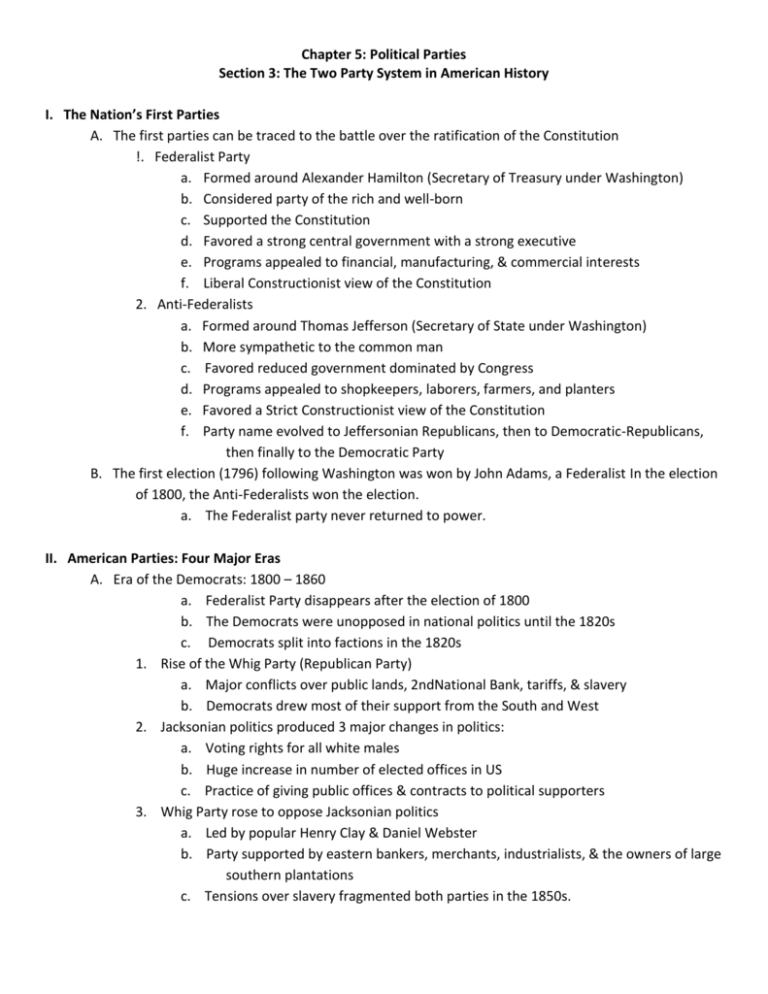
Chapter 5: Political Parties Section 3: The Two Party System in American History I. The Nation’s First Parties A. The first parties can be traced to the battle over the ratification of the Constitution !. Federalist Party a. Formed around Alexander Hamilton (Secretary of Treasury under Washington) b. Considered party of the rich and well-born c. Supported the Constitution d. Favored a strong central government with a strong executive e. Programs appealed to financial, manufacturing, & commercial interests f. Liberal Constructionist view of the Constitution 2. Anti-Federalists a. Formed around Thomas Jefferson (Secretary of State under Washington) b. More sympathetic to the common man c. Favored reduced government dominated by Congress d. Programs appealed to shopkeepers, laborers, farmers, and planters e. Favored a Strict Constructionist view of the Constitution f. Party name evolved to Jeffersonian Republicans, then to Democratic-Republicans, then finally to the Democratic Party B. The first election (1796) following Washington was won by John Adams, a Federalist In the election of 1800, the Anti-Federalists won the election. a. The Federalist party never returned to power. II. American Parties: Four Major Eras A. Era of the Democrats: 1800 – 1860 a. Federalist Party disappears after the election of 1800 b. The Democrats were unopposed in national politics until the 1820s c. Democrats split into factions in the 1820s 1. Rise of the Whig Party (Republican Party) a. Major conflicts over public lands, 2ndNational Bank, tariffs, & slavery b. Democrats drew most of their support from the South and West 2. Jacksonian politics produced 3 major changes in politics: a. Voting rights for all white males b. Huge increase in number of elected offices in US c. Practice of giving public offices & contracts to political supporters 3. Whig Party rose to oppose Jacksonian politics a. Led by popular Henry Clay & Daniel Webster b. Party supported by eastern bankers, merchants, industrialists, & the owners of large southern plantations c. Tensions over slavery fragmented both parties in the 1850s. 4. The Democrats split into 2 major groups, the North and the South. a. The Whig Party fragmented and disappeared, leaving several smaller parties trying to attract the former Whigs. b. The most successful of these smaller parties were the Republicans. c. The Republicans managed to draw many Whigs and anti-slavery Democrats. 5. Although the Republicans unsuccessfully ran a Presidential candidate in 1856, they managed to get Abraham Lincoln elected in the election of 1860. B. The Era of the Republicans: (1860-1932) 1. Republicans would dominate the Presidency for the next 75 years. a. They were supported by business & financial interests, farmers, laborers, & newly freed slaves. 2. The Democratic Party was able to survive mainly in the “Solid South”. a. They slowly began to rebuild their electoral base. 3. Although Democrats managed to intermittently capture the Presidency, their stay was usually short-lived. 4. Although the Democrats lost the election of 1896, they did manage to accomplish 2 key changes: a. The Democrats campaigned as the “champion of the little man”, forever cementing the Democrats as the defender of the poor and disaffected citizens of our country. b. They managed to shift national politics away from sectionalism & back toward economic issues. 5. In the election of 1912, Teddy Roosevelt was attempting to gain the nomination of the Republican Party. a. He had previously served one term as President. 6. The Republicans chose the incumbent, William Howard Taft, as their candidate. 7. Roosevelt left the Republicans and set up the Bull Moose Party, a splinter party. a. This effectively split the Republicans into 2 voting groups, allowing the Democrat, Woodrow Wilson, to win. 8. Wilson won twice, but the Republicans regained the White House in 1920 & held it until 1932. C. The Return of the Democrats: (1932-1968) 1. The Republicans were unable to deal with the Great Depression which began in 1929. 2. The Democrats, led by Franklin Roosevelt, won the 1932 Presidential election. 3. This election marked a fundamental change in the role that Americans thought the government should play in their life. a. Previously, they wanted government to stay out of their lives. 4. The Depression firmly rooted the idea that sometimes it is government who can best help the people. a. The people really didn’t care how much the government became involved in business or industry as long as the economy got better. 5. Roosevelt was supported by southerners, small farmers, organized labor, and big-city political organizations. a. Roosevelt was elected to 4 terms as President. He died in 1945. b. His Vice-President, Harry Truman, finished Roosevelt’s 4th term and was elected to a term of his own. 6. Dwight Eisenhower, a Republican, was elected to 2 terms, in 1952 & 1956. 7. The Democrats regained the Presidency when John Kennedy was elected in 1960. 8. Following his assassination, Lyndon Johnson served out Kennedy’s term and was elected to one of his own in 1964. D. Start of a New Era (1968-Present) 1. Richard Nixon, a Republican won the White House in 1968 & again in 1972. a. Although he was very successful in foreign policy, he was caught up in illegal actions in the Watergate Scandal. b. Facing impeachment, he resigned in 1974. His VP, Gerald Ford, served the remainder of his term. 2. Due in part to controversy over the pardon of Nixon, Ford lost the Presidency in 1976 to his Democratic opponent, Jimmy Carter. a. Carter suffered many setbacks in the economy and the Iranian Hostage Crisis. B. Although he ran again in 1980, it was unlikely he could retain the Presidency. 3. Carter was defeated by the Republican, Ronal Reagan, in 1980. a. Reagan held the office through two terms. 4. Another Republican, George Bush, won election to the President in 1988. 5. Many political observers thought that the election of two very conservative Republican Presidents in a row signaled a move of the country to a more conservative path. a. The economy took a turn to the downside, which Bush was unable to fix. 6. He lost the election in 1992 to Bill Clinton. 7. Despite many rumors of affairs and wrong-doing, Clinton held the office through 2 terms. 8. The election of 2000 gave many mixed signals to political observers. George Bush, the younger, won the election of 2000 and 2004, but by very close margins. 9. Throughout much of the period between 1968 and the present, there has been a period of divided government. 10. During most of this period, the President and the majority of Congress were not from the same party.

